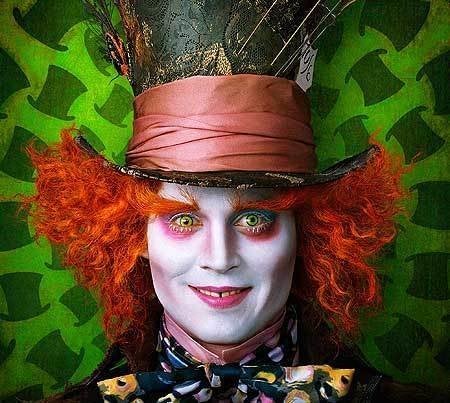
Ever since Tim Burton's Alice in Wonderland was announced, fierce debates have taken place about whether he should even have attempted such an oft-adapted story. Burton's gotten to the point in his career where he can pretty much do what he wants, and what he wants is the same thing he's always done: remaking old material in his gothic candy-horror style. But he used to pick material that was less overdone. Beetlejuice (rating: 80), Edward Scissorhands (rating: 83), and The Nightmare Before Christmas (rating: 94, directed not by Burton but by Henry Selick) are the only movies he's ever made that were based on never-before-seen, original stories, and they are three of his best. However, the problem with Alice isn't that we already know the story: the problem is that it feels curiously lifeless. The best Alice interpretations, from Czech stop-motion animator Jan Svankmajer's Alice to video game designer American McGee's Alice, take the frightening strangeness of Wonderland at face value. (Disney's enjoyable version is more trippy than scary, sort of a sequel to Porky Pig in Wackyland.) Burton, faced with the option to make Wonderland into a true nightmare, uncharacteristically blinks.
Burton's most striking gift as a filmmaker is his complete command of color, and this movie makes good use of it, illustrating the colorful battle between the Red Queen and the White Queen in the second half of the movie. However, as with Big Fish (66) -- and perhaps reflecting his background in hand-drawn cel animation -- still shots in the movie are often more compelling than the 24-frames-a-section action. The same problem plagues the screenplay, which borrows a line from "Jabberwocky" to invent a plot contrivance called the "Frabjous Day," on which she must slay the Jabberwock; another line from Through the Looking-Glass provides her most frequent refrain, "Sometimes I've believed as many as six impossible things before breakfast." The screenplay otherwise retains little of Carroll's delight in wordplay. It's a pleasant enough journey, but curiously unmemorable.
The cast, likewise, is a wonderful collection of talent that doesn't add quite as much to the whole as might be hoped. Relative newcomer Mia Wasikowska makes for a very good Alice, escaping into her dreams to get away from a marriage she wants to avoid. But while Johnny Depp's Mad Hatter (whose frequent lapses into a full-throated Scottish accent are never explained) is the male lead and the face on all the movie posters, he's neither insane enough nor heart-throbbing enough to justify his top billing. Helena Bonham Carter's Red Queen is gleefully malevolent, but Anne Hathaway's pancaked White Queen makes less of an impression. Crispin Glover's Stayne, the Red Queen's retainer, is menacing but no more. (It's unclear whether the name is an intentional reference to Tim Burton's animated character Stainboy.) Voicework by Stephen Fry, Michael Sheen, Timothy Spall, and Imelda Staunton comes and goes without a trace, but Alan Rickman's hookah-smoking Caterpillar, Matt Lucas's Tweedledee and Tweedledum, and Christopher Lee's Jabberwock fare better. Burton's developing something of a repertory cast now: Depp, Bonham Carter, Rickman, and Spall were all in his last film, Sweeney Todd (rating: 79), and Lee was cast but left on the cutting room floor. This reliance on repertory helps contribute to the impression that we've seen it all before.
Throughout the movie, the Mad Hatter repeats one of the most famous nonsense lines from the book: "Why is a raven like a writing-desk?" He has no idea of the answer, nor does Alice; the author, Lewis Carroll, wrote it with no answer in mind. But after years of being bothered by curious readers, Carroll finally devised a solution: "Because it can produce a few notes, tho they are very flat; and it is never put with the wrong end in front!" That's also a fair description of Burton's movie: it retains some notes of the original work -- striking, strange, and diverting for two hours. But compared to previous takes on the same material, they come off a bit flat.
Rating: 63
Crossposted on Remingtonstein.